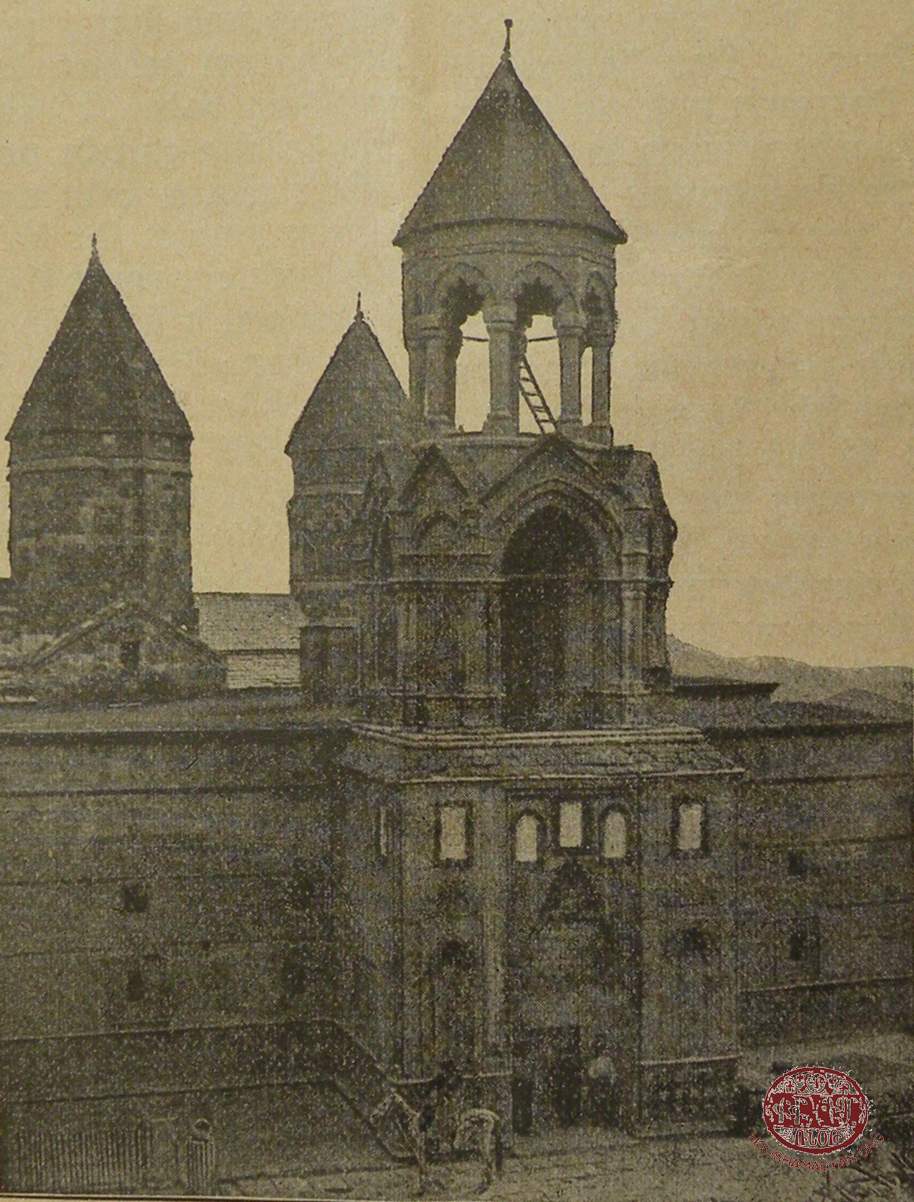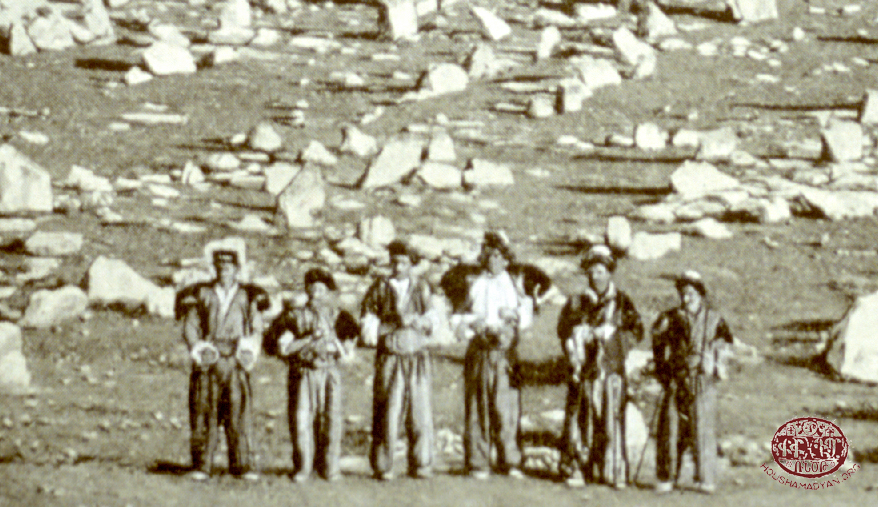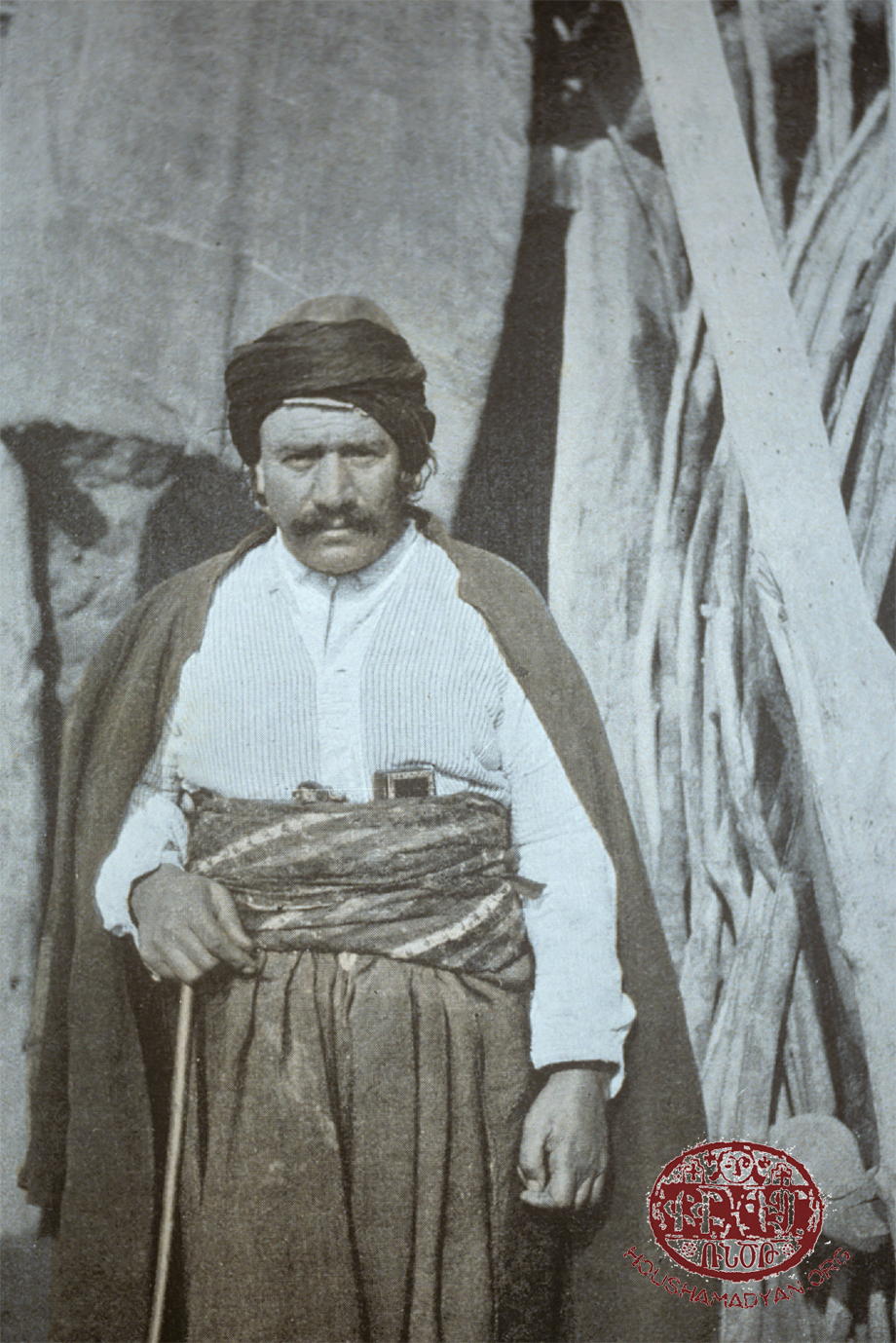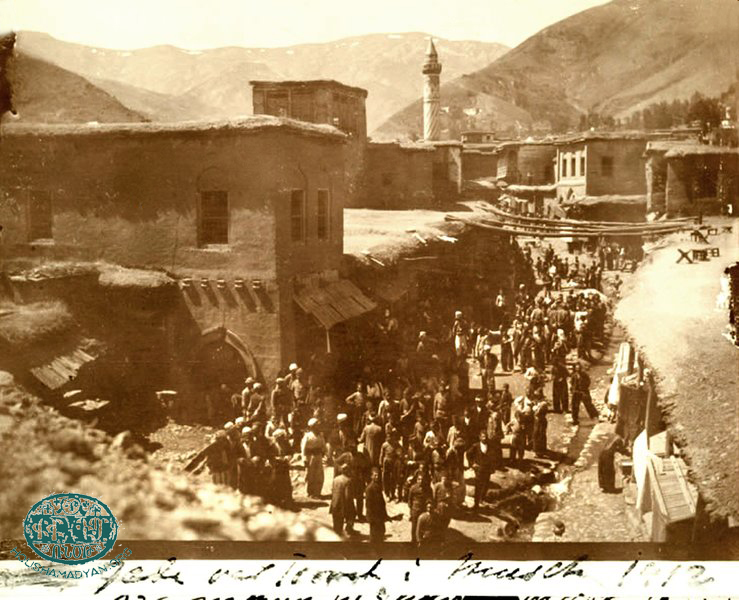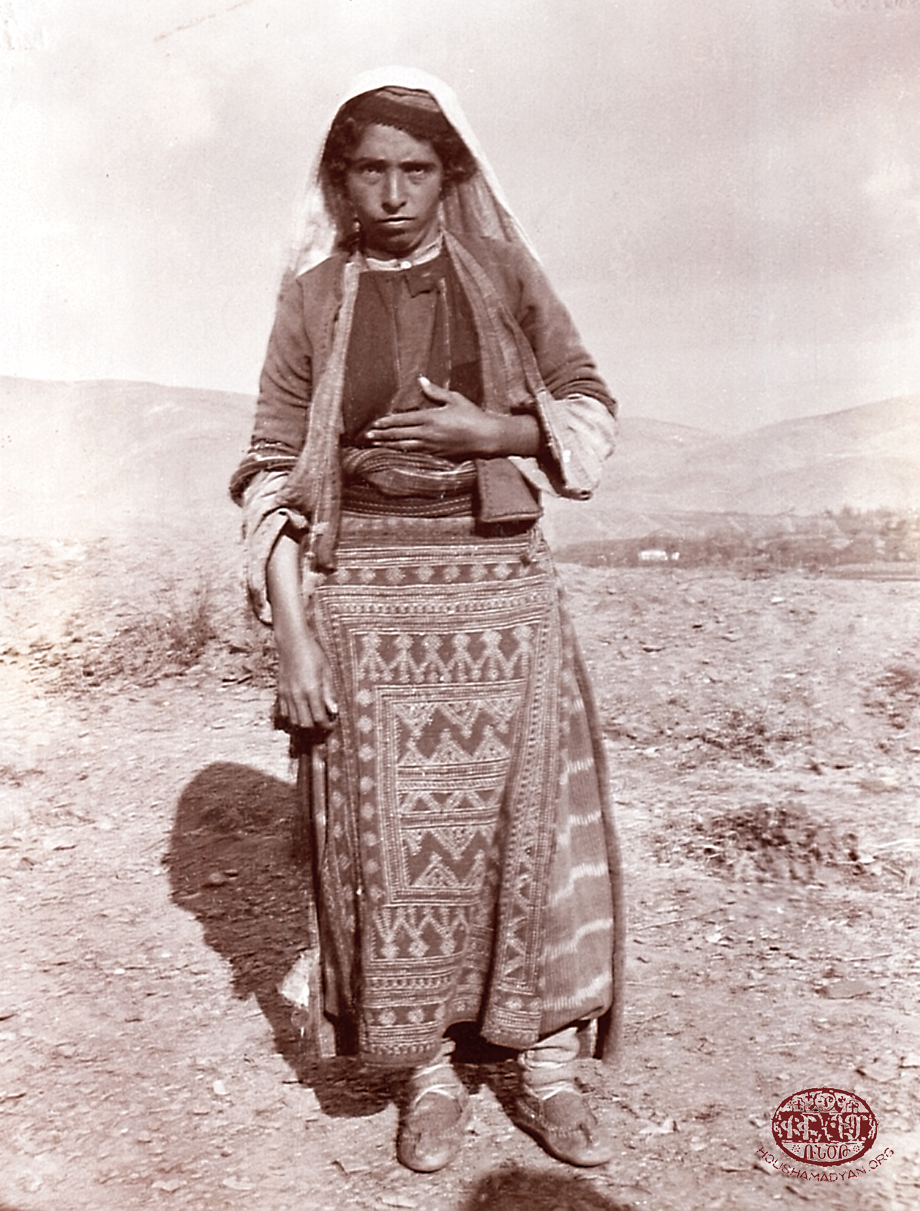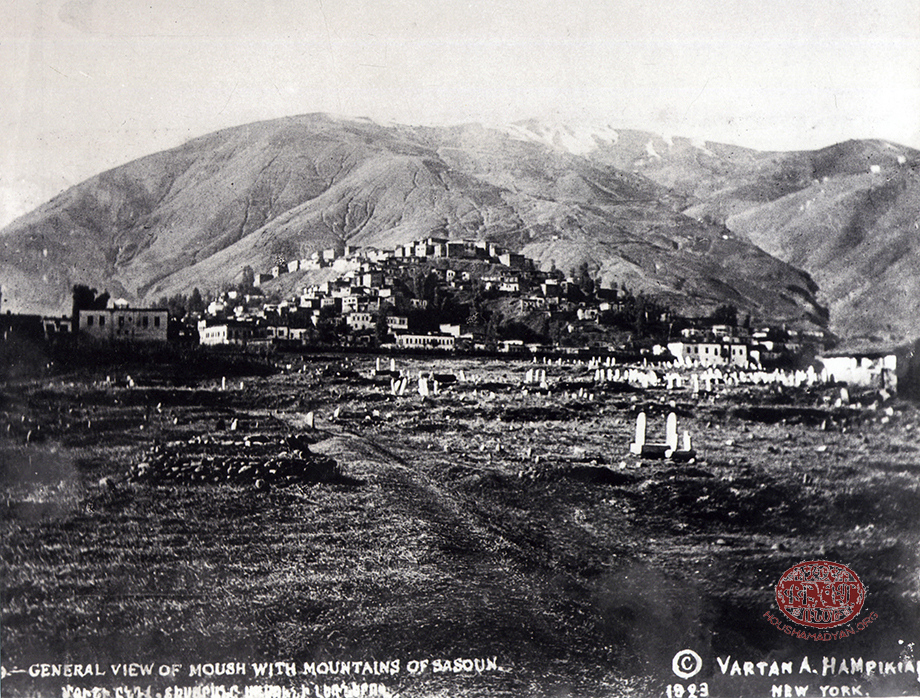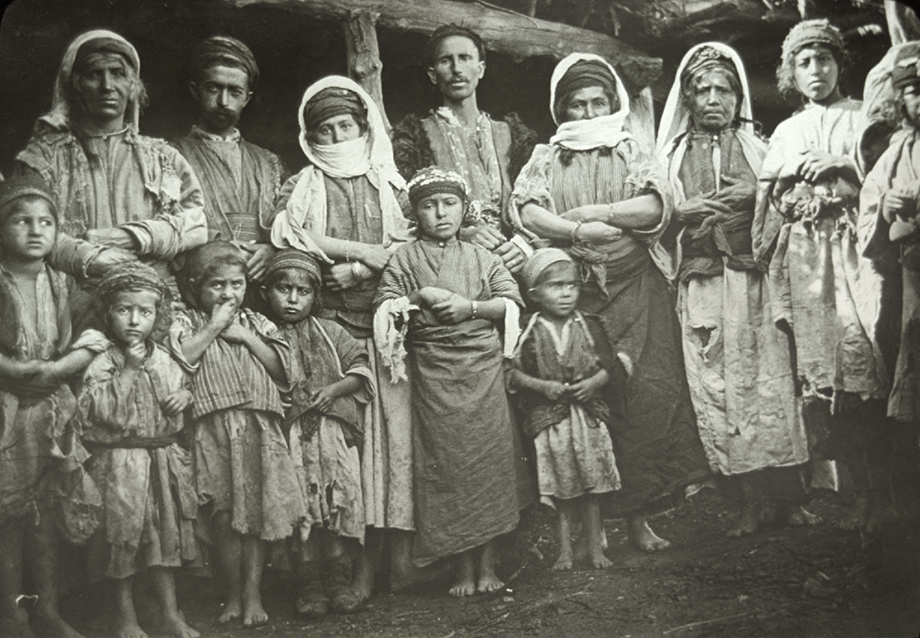Moush – Song and dance
Author: Armine Hakobyan, 21/11/2016 (Last modified: 21/11/2016) - Translator: Simon Beugekian

Msho ashkharh anoush e,
Sarn ou tsorn msoush e,
Husis kamin kshe zis
Our dzotsi mech taghe zis. [1]
The City of Moush has been mentioned in historic records since ancient times. Research has linked the etymology of the name of the city to various ancient tribes, geographic appellations, political events, or other natural phenomena. According to widely accepted tradition, the name of Moush is considered to be a derivative of the Armenian word mshoush, meaning fog. Legend holds that the Goddess Astghig, the Goddess of fertility of love in the ancient Armenian pantheon, would cause fog to descend around her while she bathed in the River Arsanias near Moush (modern-day River Murat, also called the Eastern Euphrates) [2]. The echoes of this pagan myth can also be found in the dance song Msho Sarer Mshoush e, transcribed by Gomidas:
Msho Sarer Mshoush e [3]
MUSIC SCORES PDF
Msho sarer mshoush er
Har naz, har naz
Har nargis.
Msho khod chour anoush er,
Har naz, har naz
Har nargis.
This is an example of a simple popular ditty, also called Le-Le in Gomidas’s time, and that’s the name given to it in his original transcription. Two more verses of it were also widely known –
Msho gakav hergen viz,
Msho marter ghochakh er. [4]
Another unique song that Gomidas transcribed from the Moush area was titled Mshetsots Bingeol, which resembles a ballad [5].
A Bingeol is a type of song that is structured around vocal improvisation, unique in the catalogue of historical Armenian music. Bingeols were particularly popular in Western Armenian communities, and individual songs were usually named after specific regions or areas, attesting to the origin and/or the style of the song. Bingeols were sung both in Armenian and in Turkish [6]. Gomidas’s source for his transcription of Mshetsots Bingeol was a man from Moush named Moushegh [7].
Musicologist R. Atayan affirms that Mshetsots Bingeol, in view of its aesthetic and technical characteristics, as well as its emotional impact on listeners, can be distinguished from run-of-the-mill folk compositions of the time, and can be classified as a professional-popular work of music [8]. In fact, Atayan considers the song to be a prototypical example of professional-popular music, worthy of classification as one of the many folkloric treasures unearthed by Gomidas [9].
Moushetsots Bingeol (Turkish) [10]
Kharpourt yoli vourtoum keltim
Bingeol – svi nartan akar
Araz – svi pogh – boulaghlar kealeim
Chayir-chiman savough soular bingeoli, bingeoli.
Gharli taghlar ashar ashar
Poura kyaltem bingeol taghna,
Slvan-slvan gharli taghlar kealeim…
Chichak sempoul kul halamshar ashar yoli bingeoli.

Odes and Historic Songs
Among the odes and historic songs transcribed by Gomidas, of particular interest is Sourp Garabedn er Mshetsi. Many Armenian songs are dedicated to Saint Garabed, perhaps the most beloved and renowned of Armenian saints, and the pilgrimage site (monastery) associated with him. These songs often praised the miraculous properties of the pilgrimage site [11]. This particular transcription of the ode to Saint Garabed, transcribed by Gomidas – as well as all other surviving versions of the ode [12] – feature a highly developed and unique melody, resembling a ballad [13].
Sourp Garabedn Er Mshetsi [14]
Sourp Garabedn er Mshetsi
Tor vor gatsi na hishetsi
Mditses yelav, nsda latsi
Mourads yelov, yela knatsi.
Mouradadour Sourp Garabed!
Sourp Garabed partser degh e,
Ou chors polor Hayots kegh e.
Madagh perin karan ou makin,
Madagh erin sourp Giragin.
Mouradadour Sourp Garabed!
Sourp Garabed partsrig polor,
Ir jampakhn al volor-molor,
Ir tourn gukan shad oukhdavor,
Vor bayavor, vor tsiavor.
Bayavorin mourad ida,
Tsiavorin garmir khntsor.
Mouradadour Sourp Garabed!

Satirical songs
Among the songs transcribed by Gomidas, Mayram Ganchek Hanek Tours stands out as an example of a satirical song, featuring popular humor and parodies.
Mayram Ganchek Hanek Tours [15]
Mayram Ganchek Hanek Tours
Asdvadz arner aziz lous.
Additional verses were written to the tune of “Van Songs” by Spiridon Melikian and K. Kartashian [16]:
Arevn arne louse lous
Mayram ganchek togh gya dus,
Es inch khosk er ikha dus,
Asdvadz arner aziz lous.
Maryam aroun trer i,
Derder yakhen brnir i,
Yergou chamich dver i,
Desvergou bak arer i,
Alouchi dzar tzaghger er,
Mayrame dage barger er,
Alouchi dzare godjger er,
Mayramou por dedjger er.
Hay Maryam, Maryam, Maryam,
Jan Maryam, Maryan, Maryam,
Jan Maryam, Maryan, Maryam,
Im jan ker janin hayran.
Another version of this song, in the form of a poem, appears in the third volume of Armenian Song and Verse. The author, Mihran Tumajan, was able to record A. Alikhanian, a singer specializing in songs of Moush, reciting it as follows [17]:
Lousnagn yelav, lousne louys
Mayram ganchek hanenk tours,
Ad inch khosk er tsekets tours
De…
Der… Avdoulin harsner…
Mayram hichi khiyarnots,
Kagher khiyar, letsouts dzots,
Garav ir vezi veznots.
De vourma, vourma, vourma,
Choukhd me maki ghavourma.
Gakav haver getsetsin,
Garmi kinin khemtsoutsin.
Lousnag tseker badin dag,
Mayram barger cheli dag.
Avdali tour shesherov,
Mayram darin kisherov.

Wedding Songs
Among the many songs from Moush transcribed by Gomidas, there are several weddings songs, including Ver Eli, Hay!; Kharsig Ver Are!; Me Korse Tanina; and Shvage Zave. Wedding ceremonies in Moush were unique, and included many rites – the arrangement of the marriage between families, the first visit of the groom’s family to see the bridge, the engagement, the first shared meal, the first visit of the groom to the bride, khoncha-pokhcha (the sending of presents by the groom to the bride prior to the wedding), dashdadronk (a gathering of the bride’s and groom’s relatives on the Friday prior to the wedding), azbalvatsk (the laundering of the groom’s clothes for the last time before the groom is married), hinatrek (the sending of a meal of bread and fruits from the groom’s home to the bride’s home), gendrel/trash (the procession that leads the groom, dressed in his wedding suit, to his new home), the wedding, etc. Naturally, for the inhabitants of Moush, song and dance were an integral part of most of these traditional wedding rites.
The people of Moush were superstitious. Weddings were arranged by families while their children were still in their cradles. Songs called ororotsakhaz (cradle tunes) were sung over the cradle to mark the occasion of the choice of the infant’s future mate (the infant’s parents would draw a musical note on the roof of the cradle while singing these songs) [18]. In some cases grooms and brides only met each other for the first time on the day of their wedding. The wedding ceremony itself was accompanied by songs, dances, and unique local rituals. For example, this song was sung while the bride was dressed in her wedding gown [19] –
Dnig ou shemkig,
El touk mik jaja!
Menk ink jajalou,
Shoghig danelou.
Aghprig el chedzemdzemas,
Maghig el chekhelvelas
Menk ink erralou,
Shoghig yeramen chogelou.
Kisher, tou dari yeghir!
Aghotran tou le heratsir,
Mer yeram hasrat hanir!
Es antarts, oghoup orin.
As the bride left her parents’ home, her pockets would be filled with raisins and a few pairs of small socks. At this time, the girls around her would sing [20] –
Chchamich maghov maghetsin,
Shogheri jeper letsretsin,
Chgharip jampa tretsin.
Tradition also proscribed the sweeping of the bride’s parental home immediately after her departure, in order, supposedly, to stave off a disaster befalling her parental home. The girls in the bridal party would sing [21] –
Merig, me avli zedakhdig,
Vor chavir kou aghchega hedig,
Tegh mna ki nmoushig,
Vor hanis kou serdi hasratig.
The bridal party, in the countryside, would place wheat in the bride’s shoe to invite good fortune. In the city, the wheat was replaced with spare change [22]. Meanwhile, the groom’s party would attempt to steal a lid [pot lid?] from the bride’s home, supposedly to ensure that she would be acquiescent; and a spoon, supposedly to ensure that her fortune would not remain behind in her parental home [23].
Then, accompanied by musicians playing the dhol and the zurna, the bride would be led to the church. As the bride was led out of her parental home, the following song would be sung [24] –
Kharsig Ver Are! [25]
MUSIC SCORES PDF
Khars ver ari, naz me ane!
Peshert dour ver, toz mi ane.
Khars, ver ari ko takhden,
Kankead m’ane ko pakhden.
Khars, ver ari ko otits,
Kankead m’ane ko pakhdits. [26]
After the end of the church ceremony, the bride and groom would be led to their new bridal home. As they approached the home, the following would be sung –
Takvori her durs ari,
Pounch me shoushan ink peri,
Takvori mer, durs ari,
Top mi khoutn ink peri,
Takvori aghper, durs ari,
Abeshme pejgir m’ink peri. [27]
In the countryside, the groom’s mother would meet the couple carrying bread. She would place a piece of bread on the bride’s head, then would begin dancing holding the rest of the bread. Meanwhile, a member of the wedding party would come forward and break a jug right in front of the newly married couple. This act was believed to ward off ill fortune. Some of the other members of the families, from the nearby roofs, would shower the bride with raisins, walnuts, and even spare change. The priest would then invite the groom’s mother to kiss the Bible, while one of the older members of the wedding party would recite the following [28] –
Ov chaghamat! Hantisagank,
Touk le orhnek mer takvorin
Vor mer choukhdag dzelin dzaghgin,
Entrants bedoughk mangounk yeghnen.
Touk orhnelov mer arev-lousin,
Menk le ge khentrenk verin horin,
Vor merchoukhdagi aghoupatin
Parov kherov vortikt hasnin.
The song Ver Eli, Hay! was sung to invite the mother of the groom to dance [29] –
Ver Eli, Hay! [30]
Ver eli, hay! Ver eli!
Kharsi gesour, ver eli!
Ver eli, hay! Ver eli!
Takvori mer, ver eli!
Two other interesting wedding songs transcribed by Gomidas are Me Kors Tanina and Shegave Zave. Even though the songs are in Kurdish, they are prototypical Armenian wedding songs of Moush. The musical qualities of the songs have little in common with other Kurdish songs, while on the other hand they resemble traditional Armenian songs, specifically those that praise the groom. The meter used at the end of the songs also attests to their antiquity.
These songs were included among Gomidas’s collection of Armenian folk songs of the countryside. In the original manuscript, Gomidas included the note “Kurdish. Transcribe the tune” [31].
Me Korse Tanina (Kurdish) [32]
Shegave Zave (Kurdish) [33]
MUSIC SCORES PDF
Shegave zave taza,
Laog kher pezava.
Shegave zave taza,
Laog kher pezava.
Taji perenchi khasa,
Laog kher pezava.
The song Vay Mayrig, Zis Daran! was sung in praise of the bride. In its composition, it is a dance song; in its content, it is poetic; and in its dialectical purpose, it is a wedding song [34]. It contains words of praise for the bride (Nikyar mener haloug yegh), fond words of farewell (Vay mayrigs, zis daran!), as well as words of consolation (Daran, daran, togh danin!) This song was also sung, absent a wedding ceremony, as a dance song and a love song [35].
Vay Mayrigs, Zis Daran! [36]
Source: Gomidas State Conservatory of Yerevan; Repository of the Department of the Study of Armenian Folklore - Archive.
Vocalist: Parsegh Sdepanian
Transcribed by: A. A. Pahlevanian
Arjeshou sar yergou herg,
Vay! Mayrigs! Zis daran.
Arjeshou sar yergou herg,
Kaghin, Nikyar! Zis daran,
Daran! Daran, togh danin,
Or me esor gou perin.
Vay! Mayrigs, zis daran!
Chikyares kantin, daran.
Kaghin, Nikyar! Zis daran,
Chikyares kantin, daran.
Nikyar mner haloug yegh,
Vay! Mayrigs! Zis daran.
Nikyar m’ner haloug yegh,
Kaghin, Nikyar! Zis daran.
Kaghin Nikyar! Zis daran,
Yamman! Nikyar! Zis daran,
Kaghin, Nikyar! Zis daran.
Arjeshou sar khesherov
Vay! Mayrigs! Zis daran.
Arjeshou sar khesherov
Nikyar daran kisherov,
Yamman! Nikyar! Zis daran,
Nikyar daran kisherov,
Kaghin, Nikyar! Zis daran. [37]
Text transcribed by: Arousyag Sahagian
This song was sung by Parsegh Sdepanian. He was a man who left his native village of Tserged, in the Moush Valley, in 1915. In his hometown he was a renowned singer, and had a rich and diverse catalog of songs [38]. He was recorded by researchers singing this song at the age of 82. It was one of the many songs from Moush included under the category of songs from Talin in the survey conducted by the Folklore Department of the Gomidas State Conservatory in Yerevan in 1969, under the direction of Professor M. Proudian. The songs were ascribed to the Talin region because many Armenians living in Talin had been refugees from Sassoun and Moush in the years after 1915. The songs were interpreted by Professor A. Alina Pahlevanian of the Gomidas State Conservatory, and the text of the songs was transcribed by Arousyag Sahagian, a docent of the same State Conservatory.

Romantic/Lyrical Songs
One of the traditional songs of Moush is Hampartsman Yergoushaptin (in its many versions), which, as evidenced by the title, was sung on the occasion of the Feast of Ascension (Hampartsoum). The song is an ode to the awakening of nature in the spring, and of the return of greenery and life [39].
The Feast of Ascension was celebrated in Moush in the following way: the young shepherds of each village would adorn their cattle’s horns and heads with flowers, and would enter the village singing this song while presenting bouquets of flowers to the village’s girls and young brides.
Here are two versions of this song, both constructed as dance songs of the romantic/lyrical genre [40]:
Hampartsman Yergoushaptin [41]
Source: Gomidas State Conservatory of Yerevan; Repository of the Department of the Study of Armenian Folklore - Archive.
Vocalist: Parsegh Sdepanian
Interpreted by: A. A. Pahlevanian
Hampartsman Yergoushaptin
Hampartsman Yergoushaptin
Vertsi zpotskh ou zgerntin,
Hed kidou apin katsi
Vertsi zkhotskh ou zgerntin,
Hed kidou apin katsi
Dzoretsi, dzorpetetsi,
Mantrig-mantrig khormetsi
Dzoretsi, dzorpetetsi,
Mantrig-mantrig khormetsi
Mantrig-mantrig khormetsi,
Harur partig tmmetsi,
Haroch ternov entsoutsi
Haroch ternov entsoutsi
Hampartsman Yergoushaptin. [42]
Text transcribed by: Arousyag Sahagian
Hampartsman Yergoushaptin [43]
Vocalist: Vahan Vartanian
Interpreted by: A. A. Pahlevanian
Hampartsman Yergoushaptin
Vertsi zpotskh ou zgerntin,
Enga hed dzori apin,
Dzoretsi, dzorpetetsi,
Mantrig-mantrig khormetsi,
Khoroun khormi teretsi.
Gemig cheghav, gabetsi,
Perchams gemig aretsi
Gedig cheghav, gretsi,
Michgounk gedig aretsi,
Eghnoug cheghav ldzetsi,
Choukhdem gakav eznoug aretsi
Kharzan cheghav kshetsi
Sev ots kharzan enetsi
Kshetsi, keshmeshetsi,
Haroch ternov entsoutsi
Har knoug er, chimtsoutsi,
Yaroch kerdink seperetsi.
Nar! Nar! Nar! Nari-nay! Nay-nay!
Nari-nay! Nay-nay! Nana-nay!
Darin dasvergou amar,
Khentsorn er torme kamar,
Khentsori ges khadzadz er,
Khadzadz er, khadzmedzadz er,
Vosge cherov ardzetadz er.
Nar! Nar! Nar! Nari-nay! Nay-nay!
Nari-nay! Nay-nay! Nana-nay!
Hampartsman Yergoushaptin
Gervan ergou dekergin,
Gervan, ver boudgi kerkin,
Tatkhan irarou hor tin,
Aran zirar, yelan ver dankin.
Nar! Nar! Nar! Nari-nay! Nay-nay!
Nari-nay! Nay-nay! Nana-nay! [44]
Text transcribed by: Arousyag Sahagian
The next song provided by vocalist Vahan Vartanian. He was a refugee who left the village of Marnik in the Moush Valley in 1915. “His catalogue was traditional, and he remembered it exactly as he knew it back home. He had perfectly preserved the unique accent and singing style of Moush, and having lived with natives of Sassoun for some time in the same village, he had been slightly influenced by the Sassoun drawl.” [45]
The songs Paghoumpi; Pats tour, ari; Havar Veri; Maro; and Aravod Pari Lousoun are all examples of love songs from the Moush area.
Paghoumpi [46]
Source: Gomidas State Conservatory of Yerevan; Repository of the Department of the Study of Armenian Folklore - Archive.
Vocalist: Vahan Vartanian
Interpreted by: A. A. Pahlevanian
Paughoumpi hol!Paghoumpi tol! Paghoumpi!
Danen yela, dankov katsi, paghoumpi!
Danen yela, dankov katsi,
Paghoumpi hol! Paghoumpi tol! Paghoumpi!
Khanchar tali, yertig patsi,
Paghoumpi hol! Paghoumpi!
Salvin doun cher, nesda latsi,
Paghoumpi hol! Paghoupi tol! Paghoumpi!
Salvin katsi paghnik levatsk, paghoumpi,
Pergour lachin er matsi tats,
Paghoumpi hol! Paghoumpi!
Kamin zargets, dzotsvin epats,
Paghoupi hol! Paghoumpi,
Ov vor desav khelats kenats,
Paghoumpi hol! Paghoumpi tol! Paghoumpi! [47]
Text transcribed by: Arousyag Sahagian
Pats Tour, Ari! [48]
Source: Gomidas State Conservatory of Yerevan; Repository of the Department of the Study of Armenian Folklore - Archive.
Vocalist: Vahan Vartanian
Interpreted by: A. A. Pahlevanian
Pats tour ari, pats tour ari,
Pats tour ari, pichouz yar,
Pats tour ari, pichouz yar,
Chapink kou pajovn im, yar,
Chapink kou pajovn im, yar,
Ver kou kelkhoun vart im, yar.
Do dgha, dgha Mshetsi,
Shoun, shan vorti kolozov,
Herik antsnes mer badov,
Mer bad pelav kou apov.
Ertam, asim medzeroun,
Ikan zarkin khanchar khoroun,
Hanin zkou garmir aroun,
Tapin verkou teveroun,
Gatgeta mech kou soleroun.
Do dgha, dgha lankari,
Shelvar shabig jankari,
Kna verin taghn, ari,
Siri zkhorodign, ari.
Text transcribed by: Arousyag Sahagian
Havar Veri [49]
Vocalist: Vahan Vartanian
Interpreted by: A. A. Pahlevanian
Maro [50]
Source: Gomidas State Conservatory of Yerevan; Repository of the Department of the Study of Armenian Folklore - Archive.
Vocalist: Vahan Vartanian
Interpreted by: A. A. Pahlevanian
Ari! Maro! V’ari!
Ari! Jano! V’ari!
Maro! Yerginkn er amb,
Jano! Kedinn er tats,
Maron barker er, dzotsern er pats
Maro barker er, dzotsern er pats, yar!
Yar! Yananem! Yar! Yar!
Yar! Yananem! Yar! Yar!
Kel! Maro jan! Kel!
Ari! Maro! V’ari!
Maron saren gouker, shalagn er jakh,
Janon saren gouker, shalagn er jakh,
Maro dzamer housdegoug er, pichen er gakh,
Maro dzamer housdegoug er, pichen er gakh, yar!
Yar! Yananem! Yar!
Yar! Tonarem! Yar!
Akh! Che! Maro jan! Che!
Che! Maro jan! Che!
Ari! Maro! V’ari! V’ari!
Maron saren zouker, shalagn er pourt,
Janon saren zouker, shalagn er pourt,
Keghi chors goghm, zinavor Tourk,
Maron hern ou mer… [Inaudible]
Maroyi hern ou mer…
Yar! Yananem! Yar!
Yar! Yananem! Yar!
Che! Maro jan! Che! [51]
Text transcribed by: Arousyag Sahagian
Aravod Pari Lousoun [52]
Vocalist: Vahan Vartanian
Interpreted by: A. A. Pahlevanian
Aravod pari lousoun
Tantakh tsenig m’er eki,
Dodig hedign er katsi,
Vertsi zdodign ou katsi,
Katsi, katsi, heratsa,
Yaroch terner modetsa
Yaroch terner gisapats,
Mda g’arnenk taja hats,
Yaroch shounn er khadze zis
Hanig! Nananig! Nanig!
Entsi inch khadzel bedk er?
Entsi kirg ou dzots bedk er. [53]
Text transcribed by: Arousyag Sahagian

Dance Songs
A sizeable portion of Moush-Daron’s dance songs have been preserved thanks to the efforts of musicologist Mihran Tumajan. He was able to transcribe many dance songs provided to him by Armenag Alikhanian, a native of Moush. As Tumajan states – “the singer, Dr. Armenag Alikhanian, was born in the village of Arinch in the Moush Valley. He matriculated with the Mekhitarist Monks in Venice. He was a lover of traditional culture. His singing was not influenced by the eastern style. He had a shrill voice, and crisp enunciation” [54]. Tumajan continues – “these songs from Moush – which could best be described as dance songs – can also be found in the catalogues of nearby Van, Akhlat, and other areas. However, it is wrong to assume that the same songs sung in different areas were identical; like dialects of the same language or local versions of the national costume, there were always subtle, but noticeable differences in timbre and rhythm.” [55]
We present the dance songs transcribed by M. Tumajan in three separate categories –
1- Short songs of moderate tempo
These dance songs share a calm tempo and a tight structure.
Tsounon Eler, G’erter Ekin [56]
Vocalist: Armenag Alikhanian
Tsounoun eler, g’erter ekin,
Inkn er, our choukhd dekeragin
Ha nar nar ina,
Ha nar nar ina,
Ha nar nar ina,
Yandem Tsouno.
Tsounon eler g’erter i per,
Voch inkn eghner, voch perader!.
Tsounon Eler, G’erter Ekin was connected to the story of Tsouno, elsewhere known as Choulo, which was widely known in Moush [57].
Esor Ourpat e, Bas e [58]
Vocalist: Armenag Alikhanian
Esour Ourpat e, bas e,
Le le, zenke, zenke,
Le le, jan.
Serdigs ardzate tas e
Le le, zenke, zenke,
Le le, jan.
Serdig, maloul me gena!
Le le, zenke, zenke,
Le le, jan.
Ashkhark martou chi mna!
Le le, zenke, zenke,
Le le jan.
Choli Geroung, Ergen Viz [59]
Songwrite: Armenag Alikhanian
Choli Geroung, ergen viz,
Ham khorodig, ham nargis.
Msho sarer Meshoush er,
Hoghn ou chourn anoush er.
Hivant Em Yes [60]
Vocalist: Aremnag Alikhanian
Hivant em yes, hivant em yes,
Kou yarn em yes, kou yarn em yes,
Ar khentsore! Ari zis des!
Bdgov Pilav Yepetsi [61]
Vocalist: Armenag Alikhanian
Bdgov pilav yepetsi,
Nara, nay, nay,
Dara yaroch gertsoutsi,
Nara, nay, nay,
Nir, nay, na.
Dero, Dero, Dereggo [62]
Vocalist: Aremnag Alikhanian
Dero, dero, dereggo,
Toukh tegh kashim, dereggo.
Dero, dero, dereggo,
Haylin ishgim, dereggo.
Irek amis ashoun er,
Aghchga shabig nekhshoun er.
Zenklig [63]
Vocalist: Aremnag Alikhanian
Zenklig, aloj im kaghe,
Zenklig, daran, tekh danin!
Zenklig, zadgin tekh perin!
This last song was sung while escorting a bride out of her parents’ home on the day of her wedding. Another important piece of information regarding this song was provided by the vocalist, Armenag Alikhanian – “In the spring, when returning from the fields, boys and girls would hold hands and skip back to town to the rhythm of this song.” [64]
2. Dance songs with a heavier tempo
Apo, Mamo, Garke Zis [65]
Vocalist: Armenag Alikhanian
Apo, mamo, garke zis,
Ed hovevin me dar zis!
Gori vochkhar, dzedzi zis.
Tari nari nari na,
Tari nari nari na,
Tari nari nari na,
Nay, nay, nay.
Aghchig, Nazerov [66]
Vocalist: Armenag Alikhanian
Aghchig, nazerov, nazerov,
Tilpar, nazerov, nazerov.
Tser doun, mer doun malamoukh er
Garmir eres, achker toukh er.
Aghchig, mi ka mer doun dzoukh e!
Dadego, mi ka mer doun dzoukh e!
Garmir eres, achker toukh e.

Armenians from the Shenig and Geleguzan villages of the Moush Valley (Source: Michel Paboudjian collection, Paris)
Ari! Yar, Ari! Kherov me G’ina [67]
Vocalist: Armenag Alikhanian
Ari! Yar, ari! Kherov me g’ina,
Ita soud dounyen martou chi mna.
Dzamerou Dzanroutenen [68]
Vocalist: Armenag Alikhanian
Dzamerou dzanroutenen
Dzamtel gedrav dzovn i hengav,
Loghvori meg le yes im,
Chem hani dzamteln i dzoven.
The song Dzamerou Dzanroutenen, sung by Armenag Alikhanian, has been ascribed by some ethnographers to the legend of Ara the Beautiful and Semiramis. It is another version of the song Dzamtelig that was known widely in Van and Shadakh.
The following song, Haperpan, is one of the best examples of rural Armenian musical composition.
Haperpan [69]
MUSIC SCORES PDF
Vocalist: Armenag Alikhanian
Haperpan,
Jane jan.
Sirer im sern eresin,
Antaran tern eresin,
Ov im sirakhn ents cheda,
Asdzou gern eresin.
Samsa G’elner Parak Dzoukh [70]
Vocalist: Armenag Alikhanian
Samsa g’elner parag dzoukh,
Vay kuloum, kuloum, kuloum,
Yes yarm’ounenk Poulanoukh,
Vay kuloum er, jan kuloum.
Harav kamin magher zis,
Mech kou dzotsin tagher zis.
Tsorenn Im Tsaner [71]
Vocalist: Armenag Alikhanian
Tsorenn im tsaner, vay, yeler e bargi,
Bezgedouts sirer im, chem gerna tergi.
Her le, le, lo, lo, lo,
Yarem korani,
Her lo, lo, le, le, le,
Doktem korini.
Tsorenn im tsani, vay, ita taragogh,
Asvadz anidzer, zita ard ou hogh
Shamam cher hasner, jampenk yaroch pokh
Her, le, le…
Darona chors polor mandr ou ped kegh er,
Zen yarn or ge sirim khorodgi tsegh er,
Her le, le…
Darona chors polor mandr ou ped kegh her,
Bezdig em sirer im, khorodgi tsegh er.
Her le, le…
Another version of this song was titled Tsorenn Im Tsaner – Korani. That version is also thought to have originated in Moush [72].
Te Mayram, Mayram [73]
MUSIC SCORES PDF
Vocalist: Armenag Alikhanian
Te Mayram, Mayram, Mayram,
Te Mayram, sari jeyran.
Yarterdou sarn yousin er,
Mayramn orva lousin er.
Yarterdou sar khejerov,
Mayram nekhshoun pejerov.
Yarkhoushda [74]
Vocalist: Armenag Alikhanian
According to the vocalist, this song was also called Mrtletsoug, where the word Mrtal means shield. In his manuscript, Mihran Tumajan also notes that this song was alternatively called Game of Swords. Among the refugees from Moush in the Talin area, another common name for the song was Clap Dance [75].
Another clap dance, titled Aroushda
Aroushda [76]
Vocalist: Anoush Krikorian
Another example of popular music from the Moush-Daron area, Kochari Mesho Kher –
Mesho Kher [77]
Vocalist: Levon Seferian
These two songs were also commonplace in Khlat, an area neighboring Moush-Daron. These versions of the song are unique and differ subtly from other versions found in other areas [78].
M. Tumajan also transcribed a large amount of verse from Armenag Alikhanian. In some of these cases, Alikhanian did not remember the music associated with the lyrics, but clearly these were not merely poems, but lyrics to songs [79].
Paghchen Em Trer [80]
Paghchen em trer harchev jrakin,
Toukh rehan kejer hov erer vartin,
Ertam i Halap noush shakar perim.
Ha tri, tri, trtsenem,
Perim kezi gertsenem,
Sev havi mis gertsenem,
Garmir pourouj haktsenem.
Kerin egav pernerov,
Perner hemen karoubar,
Krkon vren saroubar.
Kou dzedzer haghortaman,
Kou peran khngi aman.
Ari ertank sari seyran,
Kaghenk tasda manishag,
Perenk talenk yortan, doshag,
Kenis etnis karnan sherchan.
Ha tri, tri trtsenem,
Sev havi mis gertsenem,
Ha tri, tedri chour i lous,
Baben kika gena tours.
Imal Enk [81]
(the title of this song is an example of the use of the first person plural when referring to the first person singular in the Moush dialect)
Imal enk, yes kou siroun, imal enk,
Meghremom tem dour koloun, imal enk,
Halenk tapenk kareroun,
Imal enk, yes kou siroun, imal enk.
Imal enk, yes kou tarden, imal enk,
Lor me terav mer arden, imal enk,
Gedrav im serdi parden,
Imal enk, yes kou tarden, imal enk.
Imal enk, yes tser dankin, imal enk,
Lousengen ver yertegin, imal enk,
Shoghenk gatenk kou kergin,
Imal enk, yes tser dankin, imal enk.
Imal enk, yes kou yabov, imal enk,
Pagheghenk ganach gabov, imal enk,
Pattevenk yelnenk tser badov
Imal enk, yes kou habov, imal enk.
Imal enk, kinov darvoug, imal enk,
Tou jerak, yes le badroug, imal enk,
Varenk tapenk kou kergoug,
Imal enk, kinov darvoug, imal enk.
Imal enk, yes kou dzotsin, imal enk,
Gayner yes mod partotsin, imal enk,
Lous dver srdanotsin,
Imal enk, yes ko dzotsin, imal enk.
Imal enk, yes kou siroun, imal enk,
Yes ag, tou aghprants aroun, imal enk,
Patsver im modi chereroun,
Imal enk, yes kou siroun, imal enk.
Children’s Rhyme: Ayp, Pien, Kiem [82]
Ayp, pien, kiem,
Prtem oudem.
Ta, yech, za,
Dakhdegeza.
E, et, to,
Topal toto.
Je, ini, lun,
Jajgi heloun.
Khe, dza, gen,
Perte dzagen.
Ho, tsa, ghad,
---- aghad.
Je, men, hi,
Zedi m’eni.
Nou, sha, vo,
Termash Avo.
Cha, be, che.
Chamich peche.
Ra, se, vev,
Godri kou tev.
Dun, re, tso,
Mer didatso.
Hur, pur, ke,
Topal kerke.
Yev, o, fe,
----.
Some of the most interesting examples of popular music from Moush-Daron have reached us thanks to one of the more talented researchers of popular music, Hayrig Muratian. Recordings of Muratian were interpreted, edited, and published by A. A. Pahlevanian in his collection Armenian Songs. Thanks to Muratian, many popular songs were rescued from being lost to obscurity. Muratian was a historian by trade, and therefore expertly collected and evaluated the popular songs he came across [83].
Hayrig Muratian had his roots in Van, and the majority of the songs he recorded originated in the Vasburagan area. But he still recorded some that originated elsewhere [84]. Some of thos songs include Msho Sarer; Yotn Or, Yot Kisher; Daran, Daran; Ko Totol Janin Mernem; and Gago, Mare!; all of which originated from Moush-Daron. These songs were among those that were appropriated by Armenians living in other parts of historic Armenia. Usually, artistic material was preserved outside of its original area of creation only when it traveled to another area where the local population already had a tradition of cultural preservation [85].
Hayrig Muratian states – “The songs Msho Sarer; Yotn Or, Yot Kisher; Daran, Daran; Ko Totol Jani Mernim; and Gago, Mare! Were all originally composed in Daron. These songs were also heard often in Shadakh, albeit with slightly different melodies. I learned the songs from peasants of Shadakh, and I also heard them in my youth, from friends of mine who were shepherds in Moush.” [86]
Msho Sarer [87]
Source: Gomidas State Conservatory of Yerevan; Repository of the Department of the Study of Armenian Folklore - Archive.
Vocalist: Mgrdich Sarksian
Msho sarer mshoush e,
Hoghn our choure anoush e,
Pobig me kele! Push e!
Khorodin bakyen anoush e.
Enkyer yes gyed, ge loghas,
Eler yes ap, ge toghas,
Pobig me kele! Push e!
Khorodin bakyen anoush e.
Kants zneran khad ge shoghas,
Sirogh serdin bakye gitas.
Pobig me kele! Push e!
Khorodin bakyen anoush e.
Yotn Or, Yot Kisher [88]
Source: CD, Hayrik Mouradian, Moks Mountains, TM Production, 2016.
MUSIC SCORES PDF
Vocalist: Hayrig Muratian
Interpreted from the vocals by: A. Pahlevanian
Yotn or, yot kisher shaghkamn i
Kodgis tormesher,
Yar mzig denen tours chelna, pshour
Mi serdig mezi khovana,
Yar le, yar le, yar le, yar le,
Yar le, yar le, yar le, yar le,
Yar le, yar le, jan le.
Ertam Istampol, tadem paren pol,
Arnem choukhdem sol, khakynenk toretor.
Arnem zim dampouren, elnam zko mamou hertis,
Zim Gakyvou anoush tsen lesis, kenits zartnis
Yar le, yar le, yar le, yar le,
Yar le, yar le, yar le, yar le,
Yar le, yar le, jan le.
Yarsi kherovav, shahgkam toromav,
Sirdsi maloulav, tartsi shadatsav.
Yar, hor tou mezi cheyir siri,
Hori yes ternen antsa? Tou kholor irishgatsir.
Yar le, yar le, yar le, yar le,
Yar le, yar le, yar le, yar le,
Yar le, yar le, jan le.
Ertam Istampol, tadem paren pol,
Arnem choukhdem sol, khakynenk toretor.
Khayer, vakh! Khayer, shivar eky matse,
Chinank mer yergri latsern ou tsaver,
Vay le, vay le, vay le, vay le,
Vay le, vay le, vay le, vay le,
Vay le, vay le, vay le.
Ertam Istampol, tadem paren pol,
Arnem choukhdem dol, khakynenk toretor. [89]
Daran, Daran [90]
Interpreted from the vocals by: A. Pahlevanian
Khenous gyeghi mech deghe,
Pekhn olorets mer sheykhe.
Zorazor khelin daran,
Torkin zis lats ou shivan.
Daran, daran zim yare,
Daran zim meg ou jare,
Havar darek Saroyin,
Saran khorod Varoyin.
Yaris dzamern er osgi,
Takma cher iga khoski,
Zoragi khelets darav
En medz sheykhe anhoki.
Daran, daran, zim yare,
Daran zim meg our jare,
Havar darek Saroyin,
Daran khorod Varoyin.
Im yar anmegh jnjghoug e,
Yara sirds teghoug e,
Medz peghi sour khanjalits
Im sird jeghoug-jeghoug e.
Daran, daran zim yare,
Daran zim meg ou jare,
Havar darek Saroyin,
Daran khorod Varoyin.
Varo er yaris anoun,
Khogh kashetsin im klkhoun
En dzour toure medz peghi,
Gedrets teler im serdi.
Daran, daran zim yare,
Daran zim meg our jare,
Havar darek Saroyin,
Daran khorod Varoyin. [91]
Ko Totol Janin Mernim [92]
Interpreted from the vocals: A. Pahlevanian
Ko totol janin mernim,
Ko sivdag toshvin mernim,
Ko toukh acheroun mernim, yar jan,
Ashoun egav kez garnim.
Yote kare tamam er,
Dzots mednele hamam er,
Ergou sivdag toshit mech, yar jan,
Posdan tsanoug shamam er. [93]
Gago, Mare [94]
Source: CD, Hayrik Mouradian, Moks Mountains, TM Production, 2016.
Vocalist: Hayrig Muratian
Interpreted from vocals by: A. Pahlevanian
Gago, mae, garke zis,
Choli grounk, ergen viz,
Touchar martoun me dour zis!
Erta charsoun, morna zis.
Gago, mare, garke zis,
Ham kyul, ham vart, ham nargis,
Tarzi martou me dour zis!
Gortsou asegh, dzedza zis.
Gago, mare, garke zis,
Choli grounk, ergen viz,
Solgar martou me dour zis!
Gortsou heroun, dzedza zis.
Gago, mare, garke zis,
Ham kyul, ham vart, ham nargis.
Julhag martou tou dour zis,
Tale mekuk, kerge zis. [95]

Patriotic Songs
Armenians in the Moush-Daron region also sang patriotic songs. One of the best examples of such songs is Mi Lar, Mayrig (Don’t Weep, Mother.)
Mi Lar, Mayrig [96]
Vocalist: Parsegh Sdepanian
Interpreted by: Alina Pahlevanian
Mayrig, m’erta pashi saren,
Kouyrig, m’erta pashi saren,
Goutajena serdis yaren,
Mayrig, m’erta pashi saren,
Kourig, m’erta pashi saren,
Goutajena serdis yaren,
Mi lar, mayrig, yes minag chim,
Mi lar, mayrig, yes minag chim,
Mi lar, mayrig, yes minag chim.
Kamin elav yeran eran,
Kamin elav yeran eran,
Kshets knats Vanaperan,
Vana havker tevavaran,
Vana havker tevavaran
Msho pashen sevavorav,
Msho pashen sevavorav
Mi lar, mayrig, yes minag chim,
Mi lar, mayrig, yes minag chim,
Mi lar, mayrig, yes minag chim.
Text transcribed by: Ar. Sahagian
Here is a military-themed song, which could also be classified as a love song or lyrical song. Let us note that in the context of this song, khoure translates into a black box. Officers of the Ottoman Army would travel around the countryside with these black boxes, conscripting men into the army. The names of all the men eligible for military service in a specific village would be placed in the black box, and then names would be picked at random, until the pre-determined number of conscripts were picked from the village.
Askyar im, Gertam [97]
Vocalist: Parsegh Sdepanian
Interpreted by: Alina Pahlevanian
Hey,
Hayots khouren egav, mayrig,
Moushn ou Poulanoukh,
Hayots khouren egav, mayrig,
Moushn ou Poulanoukh,
Yeridsart dgherk knatsin hanin tought,
Mayrig jan, gertam, kouyrig jan, gertam,
Askyar im, gertam, saltad im gertam.
Text transcribed by: Ar. Sahagian
Hovhanness-Mgrdich Sarksian, performer of and an expert in Armenian folk and patriotic music, and director of the Maratug song and dance ensemble, also hailed from Moush. He was exposed to Armenian folk music from a very young age, thanks to his father, Krikor Markar Sarksian (born in 1902 in the village of Petar, at the foot of Mount Sim, at a distance of 7-8 kilometers south of Moush), who was an accomplished performer of folk songs [98]. Hovhannes-Mgrdich Sarksian was recorded singing many of these songs by Sbiriton Melikian [99]. Another renowned singer, H. M. Sarksian, also contributed many songs to this recorded collection. Here are some examples from the recorded collection, Songs of the Motherland, interpreted by Professor Khachadour Mardirosian.
Msho Harsner [100]
Source: Gomidas State Conservatory of Yerevan; Repository of the Department of the Study of Armenian Folklore - Archive.
Interpreted by: Khachadour Mardirosian
Vocalist: Mgrdich Sarksian
Chorus: Hoy nar! Hoy nar! Hoy nare!
Nare nar, anoush yar!
Hoy jan! Hoy jan! Hoy jane!
Jane jan, anoush jan.
Mshou harsner choukhde-choukhd,
Sourp Aghperig katsin oukhd
Toukh amb yergnouts ge tsolor,
Lousnag dzaghigin ge shogher.
(Chorus)
Lousnag, zourpan, me shogha,
Msho harsner togh shoghan
Ourants zouks ou zerterouts
Toup ou derev ge toghan.
(Chorus)
Aravod louso temin,
Arevn er vanki shemin
Khorod harsner nare-nar,
Momer varen share-shar.
(Chorus) [101]
Msho Sarer Mshoush e [102]
Interpreted by: Khachadour Mardirosian
Msho sarer mshoush e,
Dzaghger e karoun, ltsver e aroun,
Khorodig, hay! Khorodig,
Our hoghn ou chourn anoush e
Icher e shaghig, patsver e dzaghig,
Khorodig, hay! Khorodig.
Gouravou partsr degh e,
Ertank mer arder, badmim zim tarter,
Khorodig, hay! Khorodig,
Our chour hiventin tegh e
Aver in dner, anpoun in havker,
Khorodig, hay! Khorodig.
Ousde zigas – khaskeghou.
Patsver e dzaghig, tartser e daghig,
Khorodig, hay! Khorodig,
Ge shororas kantsr meghou,
Gananch in arder, gananch in tarter,
Khorodig, hay! Khorodig.
Arakelots oukhdavor,
Gananch in choler, gananch in soler,
Khorodig, hay! Khorodig,
Sourp Garabed im kavor,
Ertank mer choler, nekhshim zkou soler,
Khorodig, hay! Khorodig. [103]
Em Le Zozan [104] (First version)
Source: Gomidas State Conservatory of Yerevan; Repository of the Department of the Study of Armenian Folklore - Archive.
Em Le Zozan (Second version)
Interpreted by: Khachadour Mardirosian
Vocalist: Mgrdich Sarksian
(An ode to the villages of Daron)
Chorus: Em le Zozan, em le Zozan,
Em le Zozan Zyaretsi.
Ichi Khaskegh, des partou dzar,
Tartsi Arakh, des tosd ou yar.
(Chorus)
Bargov aghoun et Pertagtsik,
Krir oudogh et Norshentsik.
(Chorus)
Parak posdov et Shemlaktsik,
Edzi godosh et Pentaghtsik.
(Chorus)
Komri varot et Marnigtsik,
Sogh dzakhogh et Havadortsik.
(Chorus)
Khargi haknots et Hitntsik,
Boudi shinogh et Tergvantsik.
(Chorus)
Dap kolozov et Tsrontsik,
Shaghkam tsanogh et Sokhkomtsik.
(Chorus)
Shad ashira et Petartsik,
Krir hedznogh et Gopetsik.
(Chorus)
Kelou pernogh et Semaltsik,
Toumpni koghtsogh et Keletsik.
(Chorus)
Toghi Oudogh et Henetsik,
Arnkou pernogh et Mshetsik.
(Chorus)
Khopi shinogh Dalvorgtsik,
Beghdnchi oudogh Esbaghantsik.
(Chorus) [105]

[1] Yervant Lalayan, Ethnographic Review, year 16, book XXVI, Tbilisi, 1916, Slovo Publishing House, Kimnazicheskaya, N1, page 147.
[2] T. Kh. Hagopian, Cities of Historic Armenia, Yerevan, 1987, pages 197-198.
[3] R. Atayan, Gomidas: The Complete Works, tenth volume, National Science Academy of Armenia, Yerevan, 2000, page 13.
[4] Ibid., page 198.
[5] R. Atayan, Gomidas: The Complete Works, ninth volume, National Science Academy of Armenia, Yerevan, 1999, page 136.
[6] Ibid., page 42.
[7] Ibid., page 135.
[8] Ibid., page 43.
[9] Ibid.
[10] Ibid., pages 66-67.
[11] R. Atayan, Gomidas: The Complete Works, tenth volume, page 181.
[12] Ibid., pages 84-86.
[13] Ibid., page 25.
[14] Ibid., page 84.
[15] Ibid., page 128.
[16] Ibid., page 196.
[17] Mihran Tumajan, Armenians Song and Verse, volume 3, Academy of Sciences of the Armenian Soviet Socialist Republic, Yerevan, 1986, page 115.
[18] Y. Lalayan, Ethnographic Review, page 157.
[19] Ibid., pages 166-167.
[20] Ibid., page 168.
[21] Ibid.
[22] Ibid.
[23] Ibid.
[24] R. Atayan, Gomidas: The Complete Works, tenth volume, page 178.
[25] Ibid., page 72.
[26] Ibid., page 28.
[27] Y. Lalayan, Ethnographic Review, page 170.
[28] Ibid., pages 170-171.
[29] R. Atayan, Gomidas: The Complete Works, tenth volume, page 178.
[30] Ibid., page 75.
[31] Ibid., page 179.
[32] Ibid., page 78.
[33] Ibid.
[34] Popular Armenian Songs and Tunes of Talin, Soviet Author Publishing House, Yerevan, 1984, page 23.
[35] Ibid.
[36] Ibid., page 67.
[37] Ibid., pages 73-74.
[38] Ibid., page 208.
[39] Ibid., page 23.
[40] Ibid., pages 22-24.
[41] Ibid., pages 154-155.
[42] Ibid., page 165.
[43] Ibid., page 153.
[44] Ibid., pages 164-165.
[45] Ibid., page 206.
[46] Ibid., page 148.
[47] Ibid., page 161.
[48] Ibid., page 149.
[49] Ibid., page 151.
[50] Ibid., pages 151-152.
[51] Ibid., pages 162-163.
[52] Ibid., page 158.
[53] Ibid., page 168.
[54] Mihran Tumajan, Armenians Song and Verse, volume 3, page 191.
[55] Ibid., page 191.
[56] Ibid., page 100.
[57] Ibid., page 192.
[58] Ibid., page 101.
[59] Ibid., pages 101-102.
[60] Ibid., page 102.
[61] Ibid.
[62] Ibid., page 103.
[63] Ibid.
[64] Ibid., page 104.
[65] Ibid.
[66] Ibid., page 106.
[67] Ibid.
[68] Ibid.
[69] Ibid., page 107.
[70] Ibid., page 108.
[71] Ibid., pages 108-109.
[72] Ibid., page 193.
[73] Ibid., page 110.
[74] Ibid.
[75] Mihran Tumajan, Armenians Song and Verse, volume 4, Academy of Sciences of the Armenian Soviet Socialist Republic, Yerevan, 2005, page 194.
[76] Ibid., page 97.
[77] Ibid., page 98.
[78] Ibid., pages 375-376.
[79] Mihran Tumajan, Armenians Song and Verse, volume 3, page 194.
[80] Ibid., pages 112-113.
[81] Ibid., pages 115-116.
[82] Ibid., pages 117-118.
[83] Alina Pahlevanian, Armenian Songs, New Book Publishing House, Yerevan, 2007, page 6.
[84] Ibid., page 10.
[85] Popular Armenian Songs and Tunes of Talin, Soviet Author Publishing House, Yerevan, 1984, page 7.
[86] Alina Pahlevanian, Armenian Songs, page 170.
[87] Ibid., page 46.
[88] Ibid., page 47.
[89] Ibid., pages 63-64.
[90] Ibid., page 49.
[91] Ibid., page 64.
[92] Ibid., page 49.
[93] Ibid., page 64.
[94] Ibid., page 50.
[95] Ibid., page 65.
[96] Popular Armenian Songs and Tunes of Talin, page 176.
[97] Ibid., page 170.
[98] Hovhanness-Mgrdich Sarksian (Mekro), Songs of the Motherland, Yerevan, pages 6-8.
[99] Sbiriton Melikian, Songs and Dances of the Armenian People, edited by M. Aghayan, HaybedHrad, Yerevan, 1949, pages 323.
[100] Hovhanness-Mgrdich Sarksian (Mekro), Songs of the Motherland, page 145.
[101] Ibid., page 144.
[102] Ibid., page 143.
[103] Ibid., page 50.
[104] Ibid., page 143.
[105] Ibid., page 49.


